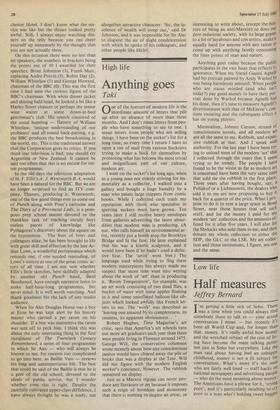High life
Anything goes
Taki
one of the horrors of modern life is the inordinate amount of letters that pile up after an absence of more than three months. And I don't mean letters from peo- ple who have something to say to one. I mean letters from people who are selling things. I have been on the sucker's list for a long time, so every time I return I have to open a ton of mail from various hucksters trying to make a buck for themselves by promoting what has become the most trivial and insignificant part of our culture, modern art.
I went on the sucker's list long ago, when as a young man not exactly striving for im- mortality as a collector, I walked into a gallery and bought a huge banality by a man who paints large snippets from comic books. While I collected such trash my reputation with those who specialise in spotting suckers must have grown. Ten years later I still receive heavy envelopes from galleries advertising the latest absur- dities that modern man is producing. (A nut, who calls himself an environmental ar- tist, recently put a bomb atop the Brooklyn Bridge and lit the fuse. He later explained that his was a kinetic sculpture, and it would have been if he hadn't used a defec- tive fuse. The 'artist' went free.) The language used while trying to flog these modern masterpieces has always made me suspect that more time went into writing about the work of 'art' than in producing it. 'Room Temperature', for example, was an art work consisting of two dead flies, a bucket of water with some apples floating in it and some uninflated balloon-like ob- jects which looked awfully like French let- ters to me. The 'work' was described as 'leaving one amazed by its completeness, its oneness, its apparent obviousness...'
Robert Hughes, Time Magazine's art critic, says that America's art schools turn out more art graduates each year than there were people living in Florence around 1475. George Will, the conservative columnist wrote recently about how any conscientious janitor would have cleared away the pile of bricks that was a display at the Tate. Will did not figure with the modern English worker's concience, however. The rubbish remained on display.
Just as a Marxist regime can never pro- duce any literature or art because it imposes such a reign of boredom and monotony that there is nothing to inspire an artist, or
interesting to write about, (except the hor- rors of being an anti-Marxist) so does our post-industrial society, with its large grants to a lot of layabouts and con artists, make it equally hard for anyone with any talent to come up with anything faintly concerning the finer points of man and nature.
Anything goes today because the public participates in the vast hoax that reflects its ignorance. When my friend Gianni Agnelli had his portrait painted by Andy Warhol he was being harmlessly amused. When people who are status minded (and who isn't today?) pay good money to have their por- trait done by Warhol because Agnelli had his done, then it's time to measure Agnelli's divertissement with that of McEnroe's con- stant swearing and the subsequent effect it has on young players.
Minimalism, Johnny Carson, stream of consciousness novels, and all modern art are all the same to me. Rubbish, and expen- sive rubbish at that. And I speak with authority. For the last year I have been trY ing to unload most of the modern 'art' that I collected through the years that I spent trying to be trendy. The people I have found to be the wisest as far as modern an is concerned have been the very same ones that sold me the rubbish in the first place. Three years after having bought, say, a Poliakof or a Lichtenstein, the dealers who sold it to me are now proposing to buy it back for a quarter of the price. What I pro• pose to do is to rent a large space in Bond Street, near those houses that sell such stuff, and list the money I paid for ttlY modern 'art' collection and the amounts of for it after five years. I will also list the Shylocks who sold them to me, and then donate my whole collection to either the SDP, the GLC or the LSE. My art collec- tion and those institutions, I figure, are one and the same.


































 Previous page
Previous page